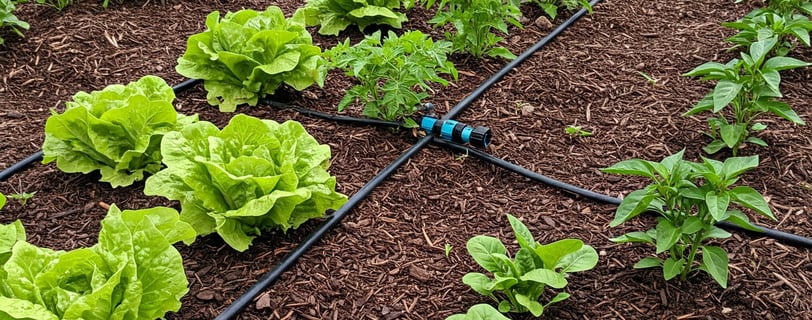What to Plant in May: Complete Growing Guide for the Month
Discover what to plant in May with our comprehensive gardening guide. Learn which vegetables, flowers, and herbs thrive when planted this month, along with expert tips for successful growth and care.
5/3/20256 min read


As spring fully establishes itself and the soil warms, May opens up a world of planting possibilities for gardeners in most regions. This month represents the perfect transition period between spring and summer planting seasons, offering ideal conditions for both cool-season crops and warm-weather favorites. Whether you're a seasoned gardener or just starting your green thumb journey, this guide will help you maximize your garden's potential during this productive month.
Why May Is a Perfect Planting Month
May brings several advantages for gardeners:
Soil temperatures have warmed sufficiently for seed germination
Risk of frost has diminished in most regions
Longer daylight hours support plant growth
Spring rains help establish new plantings
Wide variety of plants can be successfully started
In fact, research shows that plants established in May often develop stronger root systems before summer heat arrives, leading to more resilient gardens and higher yields. Let's explore what you should be planting this month for maximum success.
Vegetables to Plant in May
May offers the perfect opportunity to plant both cool-season crops that can tolerate lingering spring conditions and warm-season vegetables that will thrive in the approaching summer heat.
Cool-Season Vegetables (For Final Spring Plantings)
These vegetables prefer cooler growing conditions but can still be planted in early May for a harvest before summer heat arrives:
Leafy Greens: Lettuce, spinach, arugula, and Swiss chard
Root Vegetables: Radishes, turnips, and beets
Brassicas: Kale, kohlrabi, and quick-growing cabbage varieties
Peas: Snow peas and sugar snap varieties
Growing tip: Provide partial afternoon shade for these cool-season crops as temperatures begin to rise, or plant them where taller summer vegetables will eventually provide natural shade.
Warm-Season Vegetables (For Summer Harvests)
May is prime time to plant these heat-loving crops once soil temperatures reach 60-70°F (15-21°C):
Tomatoes: Both determinate and indeterminate varieties
Peppers: Sweet bell peppers, hot peppers, and specialty varieties
Eggplant: Standard varieties and Asian types
Cucumbers: Slicing, pickling, and specialty varieties
Summer Squash: Zucchini, yellow squash, and patty pan
Beans: Bush beans and pole beans
Corn: Sweet corn varieties
Melons: Watermelon, cantaloupe, and honeydew
Growing tip: For tomatoes, peppers, and eggplants, using black plastic mulch can help warm the soil and improve early growth rates. Studies show this simple technique can increase yields by up to 30%.
May is an excellent time to establish your herb garden, as most culinary herbs thrive in the warming conditions:
Heat-Loving Herbs
These herbs prefer warm soil and will grow vigorously when planted in May:
Basil: Sweet basil, Thai basil, and specialty varieties
Rosemary: Upright and trailing varieties
Oregano: Greek and Italian varieties
Thyme: Common thyme, lemon thyme, and creeping varieties
Sage: Garden sage and decorative varieties
Cilantro/Coriander: Quick-growing for early summer harvests
Dill: Excellent for companion planting with cucumbers
Lavender: English and French varieties in well-draining locations
Growing tip: Group herbs according to their water needs—Mediterranean herbs like rosemary, thyme, and sage prefer drier conditions, while basil and cilantro require consistent moisture.
Flowers to Plant in May
May is perfect for establishing both annual and perennial flowers that will provide color throughout summer and fall.
Annual Flowers
These provide immediate color and bloom throughout the season:
Marigolds: Excellent companion plants that deter garden pests
Zinnias: Heat-tolerant with long-lasting blooms that attract pollinators
Sunflowers: Direct sow for summer and fall blooms
Cosmos: Drought-tolerant and attractive to beneficial insects
Nasturtiums: Edible flowers that deter pests
Petunias: Heat-tolerant with continuous blooms until frost
Begonias: Perfect for shaded garden areas
Perennial Flowers
May is an ideal time to plant these long-term garden investments:
Coneflowers (Echinacea): Drought-tolerant native perennials
Black-eyed Susans (Rudbeckia): Easy-to-grow with long bloom periods
Salvias: Available in various colors and highly attractive to pollinators
Coreopsis: Long-blooming, low-maintenance perennials
Daylilies: Reliable bloomers that multiply over time
Phlox: Fragrant summer bloomers in various heights
Bee Balm (Monarda): Attracts pollinators and beneficial insects
Growing tip: For newly planted perennials, apply a 2-3 inch layer of mulch to retain moisture and suppress weeds while they establish.




Regional Planting Considerations for May
Gardening success depends significantly on your regional climate. Here's what to consider in different USDA hardiness zones:
Northern Regions (Zones 3-5)
Timing: Wait until after your last frost date, which may be mid-to-late May
Protection: Have row covers ready for unexpected cold snaps
Focus: Prioritize cool-season crops and cold-hardy varieties
Preparation: Warm the soil with black plastic before planting heat-loving crops
Middle Regions (Zones 6-7)
Transition: May represents the main planting month for most vegetables
Diversity: Plant both cool and warm-season crops throughout the month
Succession: Stagger plantings for continuous harvests
Southern Regions (Zones 8-10)
Heat Consideration: Plant heat-tolerant varieties before summer temperatures soar
Protection: Provide afternoon shade for sensitive plants
Moisture: Establish good irrigation systems for summer drought
Focus: Prioritize heat-loving crops like okra, sweet potatoes, and southern peas
Garden Preparation for May Planting
Before planting, ensure your garden is properly prepared:
Soil Testing: Perform a soil test to determine pH and nutrient levels
Soil Amendment: Add compost or organic matter to improve soil structure
Bed Preparation: Create raised beds if drainage is a concern
Irrigation Setup: Install drip irrigation or soaker hoses for efficient watering
Mulch Preparation: Have organic mulch ready to apply after planting
Expert tip: Research from agricultural extension services shows that adding 2-3 inches of quality compost before May planting can increase vegetable yields by up to 25% while reducing water needs.
May Garden Maintenance Tips
As you plant, remember these essential maintenance tasks:
Watering: Establish regular watering schedules for new plantings
Mulching: Apply 2-3 inches of organic mulch around plants
Thinning: Thin direct-seeded crops to proper spacing
Staking: Install supports for climbing plants like tomatoes and beans
Pest Monitoring: Check plants regularly for early signs of pest issues
Fertilizing: Apply organic fertilizers according to plant needs
Expert tip: For tomatoes and other fruiting vegetables, incorporate calcium sources like crushed eggshells into planting holes to prevent blossom end rot later in the season.


Succession Planting for Continuous Harvests
One of May's advantages is the opportunity to implement succession planting—a technique where you plant the same crop multiple times throughout the season for continuous harvests.
Quick-Maturing Vegetables for Succession Planting
These crops can be planted every 2-3 weeks in May for extended harvests:
Radishes: Harvest in 21-28 days
Lettuce: Baby leaves in 30 days, full heads in 45-60 days
Bush Beans: Harvest in 50-60 days
Baby Carrots: Harvest in 50-60 days
Spinach: Harvest in 30-40 days
Growing tip: Create a planting calendar to track when each succession was planted and when to expect harvests. This helps maintain a continuous supply without gaps or overwhelming abundance.
Container Gardening in May
Don't have a traditional garden? May is perfect for setting up container gardens:
Best Vegetables for May Container Planting
Cherry Tomatoes: Compact varieties like 'Tiny Tim' or 'Patio Princess'
Peppers: Most pepper varieties thrive in containers
Herbs: All culinary herbs perform well in containers
Lettuce: Loose-leaf varieties for continuous harvests
Bush Beans: Compact varieties that don't require trellising
Cucumbers: Bush varieties or those that can be trained vertically
Container tip: Use self-watering containers or water-absorbing crystals in potting mix to maintain consistent moisture levels during increasingly warm weather.
Companion Planting Strategies for May
Maximize your garden's potential with these proven companion planting combinations:
Tomatoes + Basil: Basil improves tomato flavor and repels certain pests
Cucumbers + Nasturtiums: Nasturtiums deter cucumber beetles
Corn + Beans + Squash: The traditional "Three Sisters" companion planting
Carrots + Onions: Onion family plants help deter carrot flies
Lettuce + Tall Plants: Lettuce benefits from the shade of taller plants in late spring
Research note: Studies show that appropriate companion planting can reduce pest problems by up to 50% while improving overall garden biodiversity and resilience.
Common May Planting Challenges and Solutions
Be prepared for these common challenges:
Late Frost
Challenge: Unexpected cold snaps can damage tender plants
Solution: Keep row covers, cloches, or old sheets ready to protect plants overnight
Fluctuating Temperatures
Challenge: May often brings variable weather conditions
Solution: Harden off seedlings properly before planting and provide temporary shade during heat spikes
Soil Moisture Management
Challenge: Spring can bring either excessive rain or dry periods
Solution: Use raised beds for drainage issues; mulch heavily to retain moisture
Early Pest Pressure
Challenge: Pests become active as temperatures warm
Solution: Implement companion planting, attract beneficial insects, and monitor regularly
Final May Planting Checklist
Before you finish your May planting, ensure you've completed these essential tasks:
Confirmed last frost date for your specific microclimate
Prepared soil with appropriate amendments
Installed irrigation systems
Created a planting calendar for succession planting
Selected appropriate varieties for your climate zone
Gathered necessary supports and stakes
Acquired organic pest control options
Set up a compost system for garden waste
Conclusion: Embrace the May Planting Season
May truly represents one of the garden year's most exciting and productive months. By strategically selecting what to plant based on your regional climate and following proper planting techniques, you'll establish a garden that provides beauty, food, and enjoyment throughout the growing season.
Remember that each garden is unique—your specific microclimate, soil conditions, and personal preferences will influence what thrives in your May garden. Don't be afraid to experiment with new varieties while also relying on tried-and-true performers for your region.
With the right planning and care, your May plantings will flourish into a bountiful summer garden that rewards your efforts with fresh vegetables, beautiful flowers, and fragrant herbs for months to come.
Related Articles You Might Enjoy:
Plants That Naturally Repel Insects: Chemical-Free Protection for Your Garden
How to Make Natural Fertilizer at Home Using Food Scraps, Leaves, and Kitchen Waste
5 Types of Plants Perfect for Beginners (And Almost Impossible to Kill)
How to Build a Vertical Garden: A Practical Solution for Small Spaces
The Benefits of Growing Your Own Herbs: Save Money and Boost Health in Your Kitchen
5 Common Gardening Mistakes and How to Avoid Them: Transform Your Garden Success
How to Create a Balcony Garden: Tips for Those with Limited Space
Air-Purifying Plants for Bedrooms and Offices: Breathe Healthier Air Inside Your Home
What Is Organic Gardening and Why You Should Try It: A Beginner's Guide
How to Start Your First Organic Garden: A Beginner's Guide to Sustainable Gardening
© 2025 Homewise. All rights reserved. | Privacy Policy | Terms of Use


Cultivating wellness, inside and out
